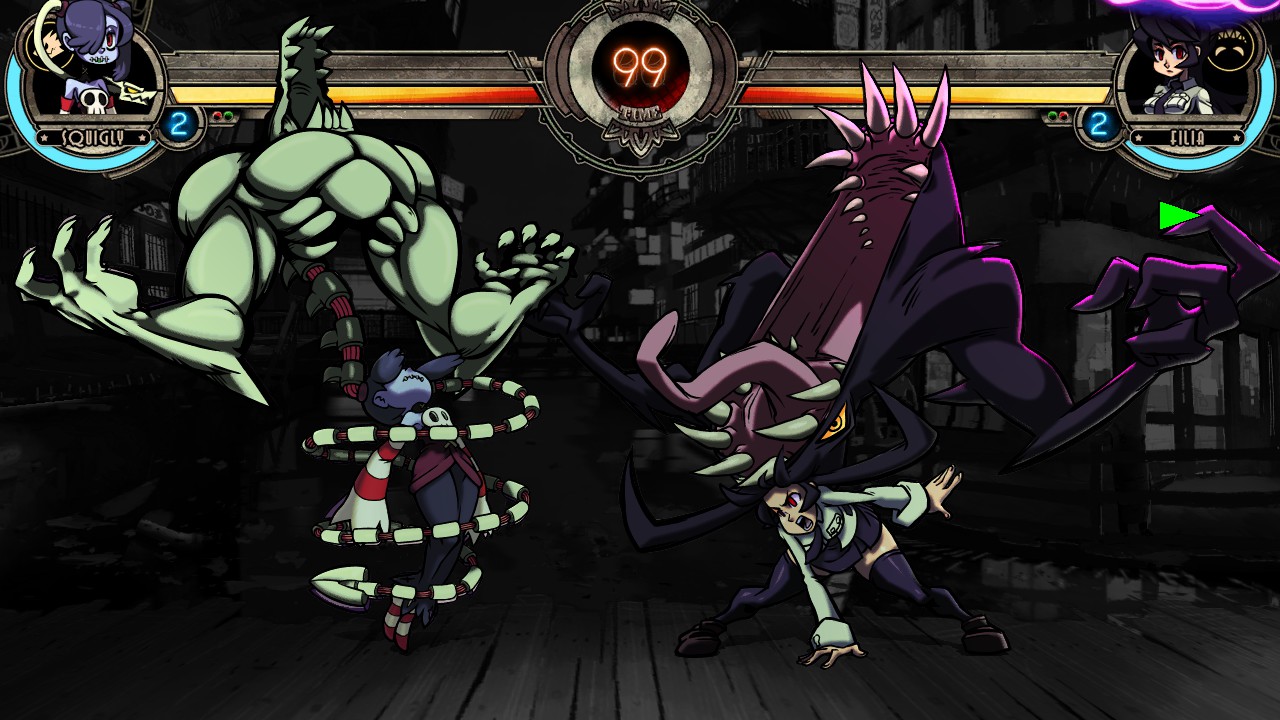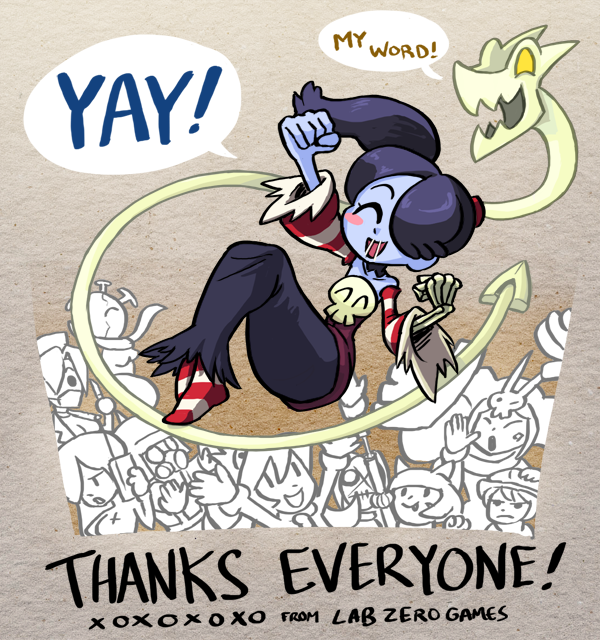Music
Skullgirls keeps its music simple, but catchy. One of the key composers is Michiru Yamane, who’s
best known for her work on the long-running Castlevania series, so the
catchiness is to be expected.
To fit with the 40s motif of the game, the music is largely
comprised of jazz-like scores and softer melodies, with lots of saxophones,
pianos, and soft drum beats. Skullgirls
uses stage themes instead of character themes, and many of them feel like
something you’d hear in a game while exploring a world in an adventure game
instead of all the guitar-rocking of Guilty Gear and King of Fighters. This works nicely and makes the different,
well-imagined locations around the Canopy
Kingdom
Combat
Again I remind you that Skullgirls was made by and for
fighting game fans. It has a very
familiar style of play anyone who knows how to make half circles can adjust to.
There are six buttons with three different punches and
kicks. Special attacks are done with the usual movements and the two weak attack buttons grab, just like in Street
Fighter 3 & 4. The super special attacks of
varying level and super meter consumption are usually done with a movement and
two buttons, much like in the Marvel vs. Capcom games, which Skullgirls’ combat
flow is also reminiscent of.
Like the Marvel vs. Capcom games, Skullgirls leans on favoring the offensive by stringing combos for as long as you can make them and stopping
your opponent’s combo to immediately fight back with your own. In a really serious fight with the best
players, someone is getting pounded at almost all times, and calling in teammates for support can help beat down your opponent further, if you have them.
Outside of the story mode, Skullgirls takes a page from
Capcom vs. SNK 2 with a ratio system for choosing characters to potentially be on a team. You can choose to fight with one character
with a lot of health, two with decent health, or three with less health.
Even though the game essentially plays like Street Fighter
mixed with Marvel vs. Capcom, I actually like Skullgirls more than MVS both
because of the nonstandard fighting styles and because it’s a little easier to
make combos due to more regular attacks striking more than once.
 |
| Plus more distance-closing attacks. |
But Skullgirls boasts some merits of its own other fighters
could learn something from.
One is its infinite combo prevention system. When a player tries to pull off a move that
loops infinitely, the system detects it and allows the player on the receiving
end to break out of it, much like a burst in Guilty Gear, but without any kind of meter. Timing is important in that combo-breaking though, because if you use it and it doesn't hit your opponent, your opponent can jump back to keep pounding you. It’s a good
idea, but frankly I don’t think anyone should even be playing against someone
who pulls crap like that.
Skullgirls also has a very well-made, extensive tutorial
mode with several lessons that walk a player through every aspect of the game
and every character’s playing style. You
don’t see effort put into tutorials like that very often, probably because all
the modern day installments of long-running fighters assume you’re already on
the ball from previous games, which I usually am.
There’s also a standard training mode that comes with some not-so-standard options like showing hitboxes and recovery times, both rather neat features worth mentioning.
These make the game a little more friendly to fighting game
beginners, and there’s enough difficulty levels in the AI to ease them into it. My sister’s something of a fan, and she never
played any other fighting game. That has
to count for something.
Personal Fighter of Choice: Squigly
Squigly comes from a famous family of opera singers, the
Contiellos, all of whom were killed over a decade prior to the events of the
game by the Medici Mafia. Before
Parasoul’s mother started the huge war, Squigly’s mother turned into the
Skullgirl and brought her back to life, where Squigly acted as one of her
mother’s many undead minions until she was defeated and put to rest once
more. Now that there’s a new Skullgirl
in town, Squigly is back again, but with her own free will this time thanks to
her loving cranial parasite Leviathan.
Squigly is one of the nicest, most honorable, polite and
adorable fighters in the game. Her
movements are like a dance and she fights perfectly in synch with Leviathan,
who is able to charge up all kinds of powerful, hard-hitting long and
close-range attacks. Even if I can't make very long combos with her, she can strike hard to make a hit really count.
Leviathan is rather aggressive in his personality, but he’s loyal enough to Squigly to stop when she asks. The two of them make for a perfect blend of grace and ruthlessness in and out of battle, just the kind of fighting I’d like in a game with characters as unorthodox as these.
Leviathan is rather aggressive in his personality, but he’s loyal enough to Squigly to stop when she asks. The two of them make for a perfect blend of grace and ruthlessness in and out of battle, just the kind of fighting I’d like in a game with characters as unorthodox as these.
 |
| And he morphs! |
The Best of the Bunch
There’s only one game to get. There’s no choice. Toward the beginning of the article I
mentioned the updated re-release of the game, Skullgirls Encore, which is the
only version to get now, since the publishers of the first version, Konami,
continued their record of being incompetent fuckheads by having it taken off every
venue it was available in.
Encore is the same as the original, but with updates, new
stages and DLC characters that were chosen by the game’s crowdfunding
campaign. So far, Squigly and Big Band
have been released, with the others, Eliza, Robo-Fortune and Beowulf, to be released at a
later date. The DLC characters are free
for a limited time at their release, so the sooner you get the game, the
better.
I suppose I can at least recommend a download platform for
Skullgirls (Encore), since it’s available for on the PSN, XBLA, and Steam. In that case, I definitely recommend the
Steam version, as it has all the content plus Steam community trading card
bonuses and very good optimization.
 |
| Each has its own original artwork. |
My computer is very weak, but even it can run Skullgirls
perfectly fine with 2D backgrounds and with very little problems with 3D
backgrounds. It’s amazing how
Skullgirls’ in-game graphics practically look just as good as The King of
Fighters 13’s, yet KOF 13 always runs in slow motion on my PC, even with static
2D backgrounds at the lowest resolution.
That’s another thing I like about indie games: I can often run them.
Other Media
Outside of the enormous amounts of fan content, Skullgirls
doesn’t really have a comic or animated series or anything similar, unless
you count the big in-game art gallery or the developer’s official blog, where
behind the scenes details and communication with the fans can be found.
It’s still relatively young, but Skullgirls would work well in another medium, like most of the other fighting games I've covered, so I hope a comic or even a web series of some kind is made someday.
Skullgirls is a lot of fun and has a lot of potential to be
a long-running fighting game franchise. For
right now though, this game on its own will do just fine for a long time to
come thanks to its well-managed updates, new (and free, for those who already
own it) characters being added and support both to and from its fans. I honestly consider it to be a hallmark of
independent game development. This is what I love
to see.





No comments:
Post a Comment